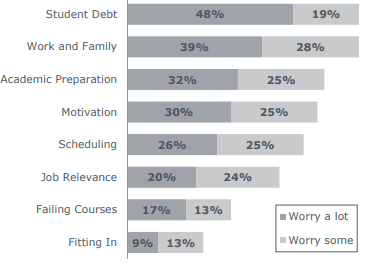The 14 practices and toolkit included in this study will help you improve applicant conversion and capture prospect mindshare through your marketing and recruitment efforts.
Executive summary: Growing pressure to recover enrollments
As the number of traditional-aged students continues to decline, community college leaders must focus on enrollment and recruitment strategies in their control. However, with an ever-growing variety of student segments, like enrichment seekers, single parents, returning veterans and working adults, it can be daunting to develop a recruitment strategy that encompasses every type of audience.
This resource is part of the Improve Communications across the Community College Student Lifecycle Roadmap. Access the Roadmap for stepwise guidance with additional tools and research.
44%
Increasing applicant conversion
Historically, most colleges have provided minimal guidance to incoming students as they navigate enrollment. At the same time, incoming students are overwhelmed by the complex enrollment process, including understanding financial aid terminology or recalling high school math placement tests. This provides an opportunity for college administrators to enhance the level of support they offer during this process.
Practice 1: Missing step enrollment prompts
Lake-Sumter State College sends personalized emails to applicants to alert them to remaining steps in the enrollment process. Admissions staff email applicants approximately five times during each admissions cycle. Each message provides instructions to complete a specific enrollment step such as financial aid, orientation, or registration.
The college has seen a substantial return on this modest investment of staff time. From 2013 to 2015, applicant conversion rates increased from 59% to 62%. This improvement generated an estimated $191,000 in annual tuition revenue (calculated under the assumption that the impacted students enrolled in an average of 20 credits per year).
Practice 2: Non-registrant phone survey
Before each semester begins, Glendale Community College partners with a call center to proactively contact all non-registering applicants. Call center agents conduct a four-question phone survey based on a script that the college provides. Specifically, the script asks applicants why they have yet to register and whether they would like support from college staff.
Because the survey occurs several weeks before the start of the fall semester, staff have time to contact applicants who request guidance with remaining enrollment steps. In 2015, 600 nonregistering applicants completed the survey, and 121 successfully enrolled in the fall semester.
Finances, Academics, and Competing Commitments: Percentage of Adult Learners Reporting Common Anxieties

Practice 3: Pre-enrollment success course

Many community colleges offer student success courses address the anxieties of current students after they enroll. In contrast, Hocking College offers a free 8-week student success course that targets prospective students who have not yet decided to enroll.
Administrators drew on the college’s existing first-year experience course and student services workshops to develop course content. In particular, the course covers the most intimidating steps in the enrollment process (e.g., financial aid, placement exams), as well as the study skills and academic resources students need once classes start. Applicants who complete the course become more likely to enroll because they feel better prepared to enter and succeed in college.
Competing for prospect mindshare
College administrators often miss opportunities to engage with prospective students as they are deciding where to apply, specifically students who are new to education. A stronger prospect engagement strategy is needed to educate these first-generation college students while various other colleges are competing for mindshare. To effectively be top-of-mind, colleges must provide consistent and tailored communication to their diverse segments.

A Prospect with Many Options
- High school senior intending to earn bachelor’s degree
- Filled out inquiry cards for 3 institutions at college fair
Practice 4: Preliminary financial aid estimates
35%
The sheer volume of university communications can make it challenging for community colleges to capture the attention of prospective students. In response, Spokane Falls Community College sends prospects personalized financial aid letters that distinguish the college based on its affordability. All prospects who list the college on FAFSA receive a letter that estimates their net cost of attendance, based on their Pell grant eligibility. Financial aid staff send about 10,000 of these letters each year.
The college first implemented this practice with applicants for the fall 2014 semester. In that semester, the college experienced a 6% increase in full-time enrollment (FTE) from the previous fall. Although the letters were one of several concurrent recruitment initiatives, administrators believe that they contributed to this substantial enrollment increase.
Practice 5: Homegrown prospect database
Colleges that do not immediately plan to invest in CRM solutions can create homegrown prospect databases to manage their recruitment activities. For example, Coastline Community College maintains a database created in Adobe ColdFusion, a web application development platform. Student workers update the database regularly with information from inquiry cards and inbound phone calls.
As of spring 2016, the database includes information on approximately 4,000 prospective students. In addition to each prospect’s name and contact information, it includes several key details such as their intended program of study, ethnicity, and high school graduation year.
Practice 6: Standardized communications plan
College administrators who seek long-term prospect management solutions should consider CRM solutions. These systems allow institutions such as Harrisburg Area Community College (HACC) to engage prospects through standardized communications plans. For example, every prospective student who inquires at HACC receives 11 automated messages through email and direct mail. These communications span a three-month period and follow a pre-determined timeline.
After HACC implemented their CRM and communications plan, their prospect to-applicant conversion rates rose to 50%, compared to just 41% two years earlier.
Why Do Prospects Leave Applications Unfinished?

Didn’t realize there were multiple pages

Simply forgot to return after navigating away

Couldn’t pay application fee to submit form

Got stuck on a question (e.g., intended major, financial plans)
Practice 7: Stalled application reminders
At colleges with online applications, admissions staff may be able to extract information from incomplete forms. As long as prospective students have already entered their name and contact information (as they typically do at the start of the form), staff can prompt them to finish their applications.
Outreach to prospects with stalled applications can occur through multiple channels. Staff can use email to provide application instructions, send text messages to announce upcoming enrollment deadlines, or use phone calls to address barriers to application.
Capturing the stealth prospect
“If we want to talk to prospective students, we’re going to have to find ways to get involved earlier in their decision-making process.”
Dean of Marketing, Public Institution
Prospective students are capable of researching colleges and deciding whether to apply, independent of contacting the college for more information. As a result, most institutions struggle to identify prospective students who do this independent evaluation. Today, this group of “stealth prospects,” who have had no know contact with the college before they applied, accounts for at least half of applicants.
Practice 8: Guidance counselor referral form
In fall 2015, Lakeshore Technical College launched an electronic referral form that allows high school staff to share the names and interests of college-bound students. High school guidance counselors and instructors can access this form on the college’s website. Because it was created in Google Forms, the college’s career coaches (who oversee outreach to partner high schools) can view all responses in a shared Google Sheet. In fall 2015, the college received 190 student referrals, which accounts for a substantial share of the 2,300 high school seniors in its service area each year.
Practice 9: Prospect-center inquiry form
900%
Fox Valley Technical College’s website includes an inquiry form designed to reflect prospective students’ preferences. This inquiry form appears prominently on every academic program page, together with information on admissions requirements and career opportunities. Prospects can easily complete this mobile-responsive form from any device. Most importantly, the form consists of four short pages instead of one long page. As prospects begin to fill out the form, a progress bar motivates them to continue to the next page.
After the college introduced this inquiry form in 2014, it generated a 900% increase in leads. In fact, the colleges received over 4,600 unduplicated inquiries in 2015.
Practice 10: Customized electronic brochure
The most effective college websites not only facilitate inquiry submission but also encourage it. Cuyahoga Community College’s website offers prospective students a personalized electronic brochure in exchange for completed inquiry forms. Prospects simply need to provide their contact information and indicate which academic programs and student services that interest them. Within minutes after they submit the form, they receive an automatically generated PDF that contains information on the selected programs and services. Not only does this practice reduce the effort required to find relevant information, but also it entices prospects to identify themselves and their interests.
The college paid a marketing vendor approximately $10,000 to develop and maintain this service in its first year. However, it generates nearly 1,500 requests for brochures each year at a cost of only $6 per inquiry. Administrators at other colleges should consider reallocating print marketing funds toward similar services. Not only does the shift toward electronic brochures reduce printing and mailing costs, but also it provides an opportunity to collect information on stealth prospects.
Practice 11: Proactive live chat
40%
While a growing number of college websites offer live chat, Ivy Tech Community College’s website includes a particularly innovative feature: proactive chat. After website visitors have been inactive for two minutes on the college’s homepage, a pop-up window appears and proposes a chat. Visitors who agree to the chat are connected with an agent as soon as they fill out a brief inquiry form.
Since the introduction of the proactive chat feature in 2015, Ivy Tech’s live chat volume has increased by 40%. In the first week of spring 2016 alone, the college received 2,400 chats. Although any website visitor may use live chat, administrators estimate that 40% of chats come from prospects.
Generating digital leads
62%
Community college recruitment typically emphasizes face-to-face events, however changes in prospective student behavior have caused progressive college administrators to reevaluate these activities. Most students are increasingly seeking college information on digital channels, like social media and engaging with paid advertisements. Understanding how and where prospects consume and receive their information is crucial to effectively engaging with them.
Practice 12: Mobile geofencing ads
In 2015, Northwest Iowa Community College partnered with an advertising agency called UpSnap to place mobile ads on over 50 popular websites and applications. The ad targeted users within a 60-mile radius of the employer sponsoring the training program, as well as users within two job centers that provided training and employment services. This approach allowed the college to promote the training specifically to job seekers within a reasonable commuting distance of the partnering employer.
The four-week advertising campaign generated over 1,700 click-throughs to the program landing page at a click-through rate that exceeded the industry average by 78%. As a result, 31 prospective students attended the program info session, and nearly half of them enrolled in the training. Ultimately, the $1,200 advertising investment yielded nearly $9,000 in tuition revenue.
Practice 13: Crowdsourced prospect engagement campaign

To conduct cost-effective social media campaigns, Clark College crowdsources content generation to students and alumni. In spring 2015, the college launched a social media campaign called “Penguins Fly.” This campaign was named after the college mascot, and it celebrated student and alumni success stories. Campaign participants shared their stories on Facebook, Twitter, and Instagram under the hashtag #penguinsfly.
Clark College’s marketing staff limited the campaign to less than four weeks to generate urgency. In addition, they designated one date as “Penguins Fly Day” so that participants felt they were participating in a special event. In advance, staff distributed lapel stickers to students and alumni to wear in the photos they posted. The graphic below depicts one of the college’s most prominent alumni—the city mayor—wearing his lapel sticker on Penguins Fly Day.
Ultimately, the campaign generated over 1,900 click-throughs, and 60 prospective students submitted inquiries or applications through the landing page.
Practice 14: Student social media ambassadors
At Southwest Wisconsin Technical College, six student social media ambassadors provide prospective students with a peer’s perspective on the college. Each ambassador maintains his or her own Twitter account, and prospects can follow these accounts to better understand students’ daily experiences. These ambassadors earn part-time wages and receive basic training in social media practices.
“Students want to hear from people their own age—people who can relate to them as prospective or current students.”
Admissions Director, Community College (Northwest)
These social media ambassadors also help admissions staff field prospects’ questions related to the student experience. Each week, ambassadors respond to a few inquiries through 15- to 30-second videos addressed directly to the prospect who submitted them. These videos require minimal time to produce because ambassadors record each one on their cell phone in just one or two takes. Moreover, they make a far more lasting impression on prospects than email responses.
Implementation toolkit
Use these 16 tools to resolve enrollment barriers, use the right channels to communicate with prospective students, design or purchase online tools that collect information on previously unknown prospects, and use inexpensive digital marketing strategies to attract new students.
Missing step emails provide applicants with instructions to complete a specific outstanding task in the enrollment process. We created a table that describes five tasks that emails may remind applicants about, and it recommends a send date based on how much time applicants need to complete the specified action.
Numerous text message vendors have emerged to provide community colleges with personalized, two-way texting capabilities. Most vendors offer the same core services, so our vendor primer help college administrators differentiate among text message platforms and decide which service best suits their campus needs.
These ten diagnostic questions help college administrators compare various text message platforms. In particular, it allows administrators to evaluate each platform according to its functionalities, ease of use, and cost.
College administrators may choose to conduct a phone survey by contracting an outside phone vendor, hiring temporary survey workers, or using college staff. This tool helps administrators decide which survey method best suits their budgetary and staff constraints. It also guides administrators if they opt to hire temporary survey workers and helps them plan for a phone survey conducted by college staff.
Non-registrant phone surveys help administrators uncover and resolve enrollment barriers for applicants. This tool provides survey workers a script to follow during conversations with applicants. Its questions are informed in part by Glendale Community College’s non-registrant phone survey.
In preparation for a non-registrant phone survey, enrollment administrators should brainstorm answers to likely applicant questions. This practice enables phone survey staff to provide detailed responses and introduce applicants to useful campus resources.
A pre-enrollment success course reduces adult learner anxieties about returning to the classroom. Typically a free, 8-week course, it targets adult learners who complete an application but do not register for classes.
Our syllabus outline is inspired by Hocking College’s JumpStart course. It provides a weekly summary of a pre-enrollment success course’s main components. It also includes a list of recommended resources for each topic so college administrators can quickly synthesize a similar course from existing materials and content.
Preliminary financial aid estimates demonstrate the affordability of community college to prospective students. College administrators can send these estimates to any prospects who request that the institution receive their FAFSA information. Use the template, informed by Spokane Falls Community College’s preliminary financial aid letter, to show prospective students the affordability of your college’s tuition and fees when supplemented with financial aid.
A drip marketing campaign allows college administrators to send automatic, pre-planned communications to prospective students. Prospects receive a steady stream of emails, letters, postcards, or other communications from the college until they complete the desired action (e.g., submit an application, register for courses). We created a calendar that describes a drip marketing campaign inspired by Harrisburg Area Community College. It illustrates the various touchpoints prospects receive after they submit an inquiry but before they apply.
A guidance counselor referral form enables high school staff to submit information about college-bound students in a central online location. College staff can then use this information to provide prospective students with information specific to their needs and interests. This tool illustrates eight essential components of a referral form.
Inquiry forms capture prospective students’ contact details and academic interests in exchange for more information about the college. This tool shows enrollment administrators and their web designers how to construct a concise inquiry form that facilitates submission.
Live chat enables community colleges to directly communicate with prospects on the college website. Live chat vendors offer a wide variety of options and services, including proactive chat windows, dynamic staffing, and data analysis. This selection guide helps administrators investigate the available options and decide which vendor is right for their campus.
This scorecard helps college administrators evaluate the wide variety of different platforms presented in the Live Chat Vendor Selection Guide. The 20 diagnostic questions listed allow administrators to systematically compare multiple platforms with similar features.
Geofencing allows community college marketing teams to serve advertisements to mobile devices within a specified geographical region. This tool helps marketing teams brainstorm potential high-yield recruitment locations within their service area.
A crowdsourced social media campaign encourages community college students and alumni to share success stories to bolster the college’s recruiting presence online. This tool provides enrollment administrators with a checklist of the most essential components of a campaign and uses Clark College ‘s “Penguins Fly” social media campaign to show how to apply the checklist in practice.
Social media ambassadors help recruit prospective students by generating and posting social media content on behalf of a community college. Because social media ambassadors represent the college’s brand online, admissions staff should carefully select students with a large and polished online presence. Our sample application, informed in part by Babson College’s Social Media Ambassador Application, illustrates how to attract high performing social media ambassadors.
Next, eliminate enrollment pain points
Our study outlines five practices for college leaders to redesign administrative processes or introduce initiatives that eliminate the most severe enrollment pain points for students.
This resource requires EAB partnership access to view.
Access the research report
Learn how you can get access to this resource as well as hands-on support from our experts through Strategic Advisory Services for Community Colleges.
Learn More